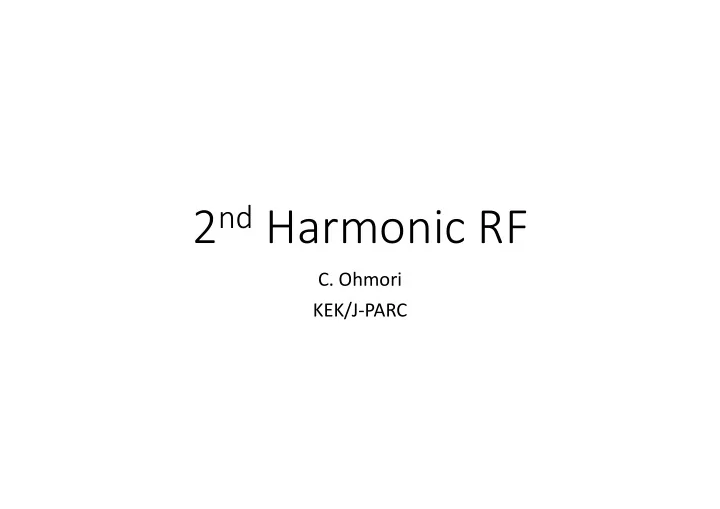

2 nd Harmonic RF C. Ohmori KEK/J‐PARC
Question from FNAL • MR is using the 2nd harmonic cavity for the space change issues. →Both MR & RCS use it. • If you have some simulation results of space charge effects and beam study results which show how it was cured after the cavity was install, we would like to know. • The Operation pattern and LLRF control would also be interesting. Is the cavity is running through the cycle? Is there anything we have to be aware of before our operation? 2016/11/10 US‐Japan Workshop
Introduction : 2 nd H RF � � � 1 � ∆ ν � � Space charge tune shift (Laslett tune shift): 2�� � � � � � � � For a large Bunching Factor (=Iav/Ipeak), Dual H at J‐PARC MR : S. Igarashi J‐PARC RCS: F. Tamura CERN PSB: M. Paoluzzi, IPAC15 Dual H acc. @ISIS : A. Seville, PAC05 2015/10/13 HINT2015 29
1 cavity drives both 1 st & 2 nd H RF Longitudinal injection painting@ RCS F. Tamura et al, PRST‐AB 12 , 041001 (2009). M. Yamamoto et al, NIM., Sect. A 621 , 15 (2010). Momentum offset injection RF voltage pattern Fundamental rf V 1 RF voltage (kV) V 2 Second harmonic rf Time (ms) p/p=0, 0.1 and 0.2% V 2 /V 1 =80% The second harmonic rf fills the role in shaping Uniform bunch distribution is formed through flatter and wider rf bucket potential, leading to emittance dilution by the large synchrotron motion better longitudinal motion to make a flatter excited by momentum offset. bunch distribution.
Longitudinal injection painting Additional control in longitudinal painting ; phase sweep of V 2 during injection V rf =V 1 sin -V 2 sin{2( - s )+ 2 } V 2 /V 1 =0 V 2 /V 1 =80% RF potential well (Arb.) (A) 2 = 100 deg 2 = 100 ⇒ 0 deg (B) 2 = 50 deg (C) 2 =0 The second harmonic phase sweep method enables further bunch distribution control through a dynamical change of the rf bucket potential during injection. (Degrees) HB2014Hotchi
Longitudinal injection painting Longitudinal beam distribution just after beam injection (at 0.5 ms) No longitudinal V 2 /V 1 =80% V 2 /V 1 =80% V 2 /V 1 =80% 2 =-100 to 0 deg 2 =-100 to 0 deg 2 =-100 to 0 deg painting p/p= 0.0% p/p=-0.1% p/p=-0.2% Dp/p (%) Dp/p (%) Dp/p (%) Dp/p (%) (degrees) (degrees) (degrees) (degrees) B f >0.40 B f ~0.15 Density (Arb.) Density (Arb.) Density (Arb.) Density (Arb.) (degrees) (degrees) (degrees) (degrees) Measurements (WCM) Numerical simulations from H. Hotchi et. al., PRST‐AB 15 , 040402 (2011). HB2014Hotchi
RF Pattern of MR RF • RF pattern : 160kV 85kV Injection : 120 kV (fundamental), 70 kV (2 nd harmmonic) • • Acceleration : 280 kV → 256 kV (fundamental) • Beam loading compensation effectively works to damp the synchrotron oscillation. • Bunching factor was measured to be 0.3 during injection. Longitudinal wave forms during injection with wall current monitor K4 K3 K2 K1
Longitudinal Profiles with Tamura High Intensity Beam of 500 kW equivalent (100 kV, 70 kV) (100 kV, 0 kV) Bunching factor Bunching factor 0.3 ~ 0.4 0.2 ~ 0.3 Bunch length Bunch length ~400 ns ~200 ns Simulation Simulation (100 kV, 70 kV) (100 kV, 0 kV)
Simulation agrees the results MR 二倍高調波試験速報 140514 田村 RCS : extraction 150 kV RCS : extraction 150 kV RCS 取り出し 150kV RCS 取り出し 150kV MR: 1 st 200 kV, 2 nd 70 kV MR: 1 st 180 kV, 2 nd 70 kV MR 基本波 200kV 二倍高調波 70kV MR 基本波 180kV 二倍高調波 70kV Simulation agrees the measurements 計算と実測は合っています
2 nd H RF at MR • Necessary to accelerate 2E14ppp • Lower peak beam current • Quadrupole oscillation damped quickly. w/o 2 nd H With 2 nd H 2016/11/10 US‐Japan Workshop 36
Hardware of 2 nd H RF Cavity: 1 st RF cavity was modified to resonate at 3.44 MHz by removing resonant capacitors. • • RF input circuit of tube AMP was modified. • APS, driver‐AMP, cavity main body are same. LLRF was set to compensate H=17,18,19 instead of H=8,9,10 for 1 st harmonics. • • Cavity gaps are always “open”. When RF voltage is not needed, still beam loading was compensated. H=18 H=17,18,19 2016/11/10 US‐Japan Workshop 37
Answers • Is the 2 nd H cavity is running through the cycle? • Yes. The voltage is applied around the injection. • When programed RF voltage is 0 V, still beam loading compensation is working. • Is there anything we have to be aware of before our operation? • For 2E14 ppp, we needed 40 A for the old 3‐gap cavity to cancel the beam loading. 2016/11/10 US‐Japan Workshop 38
Recommend
More recommend